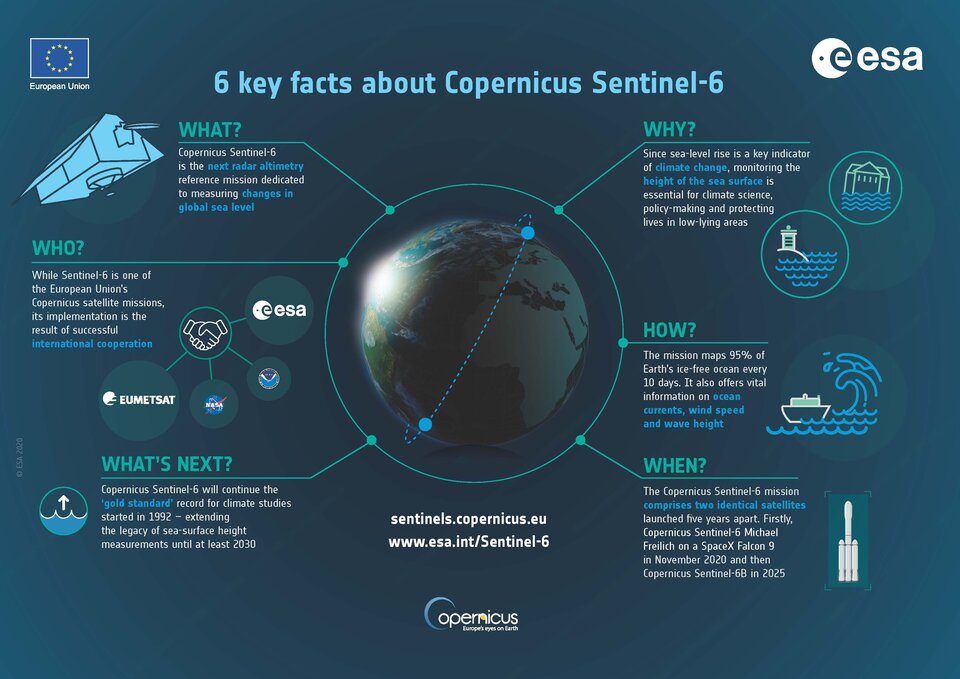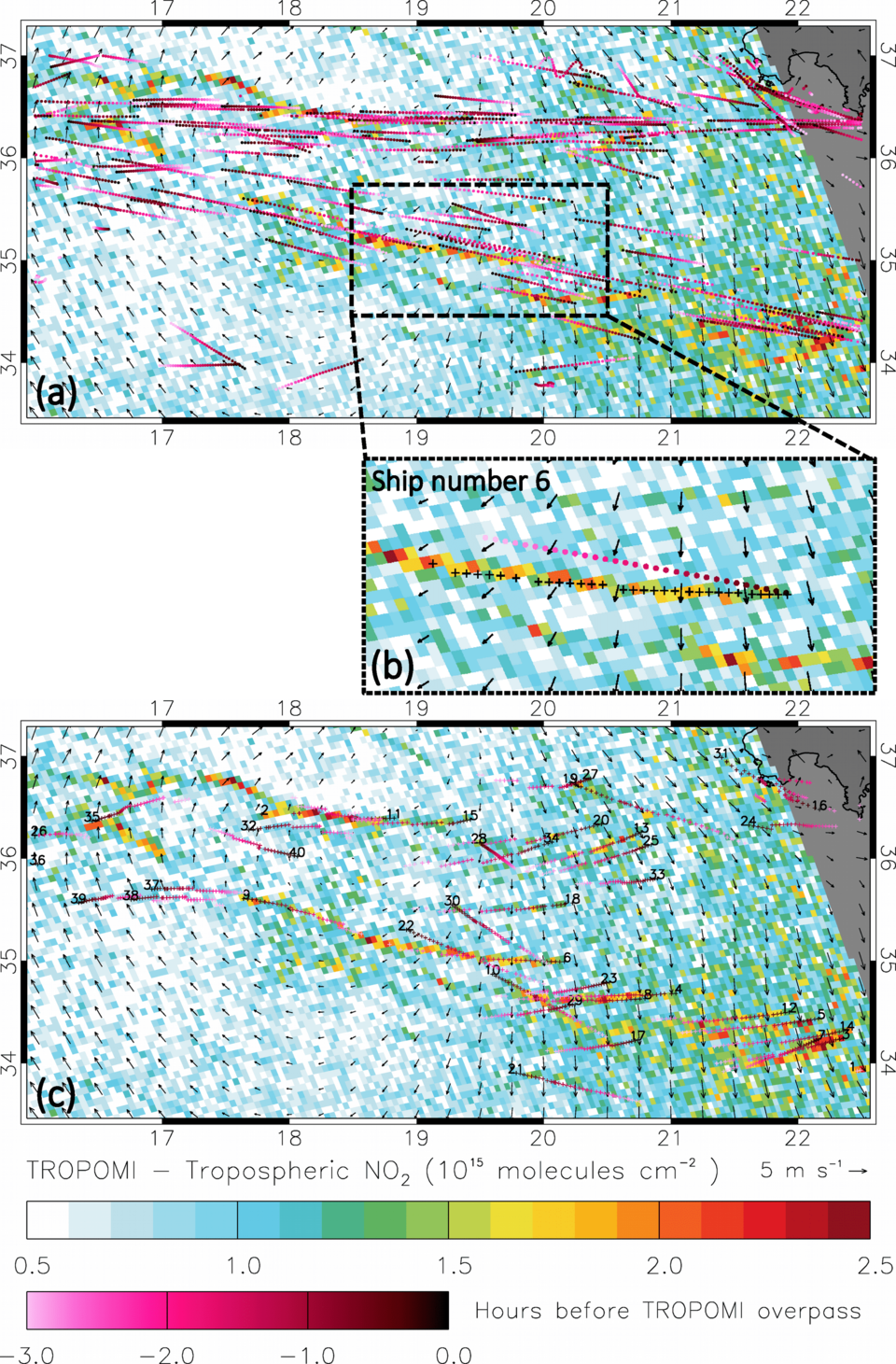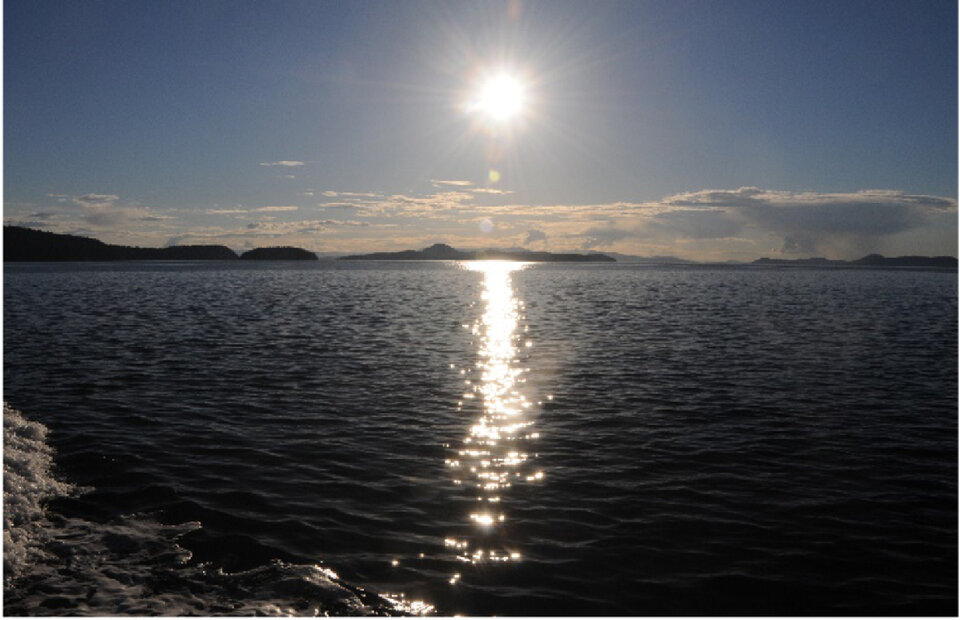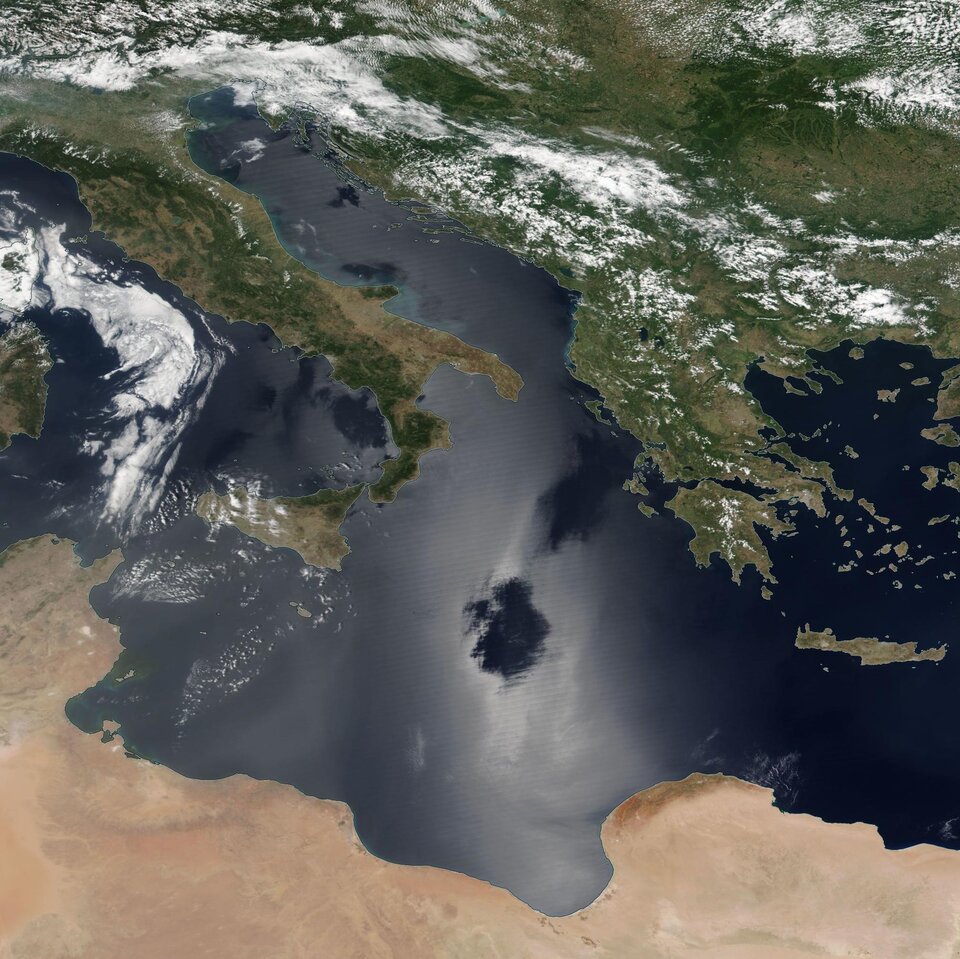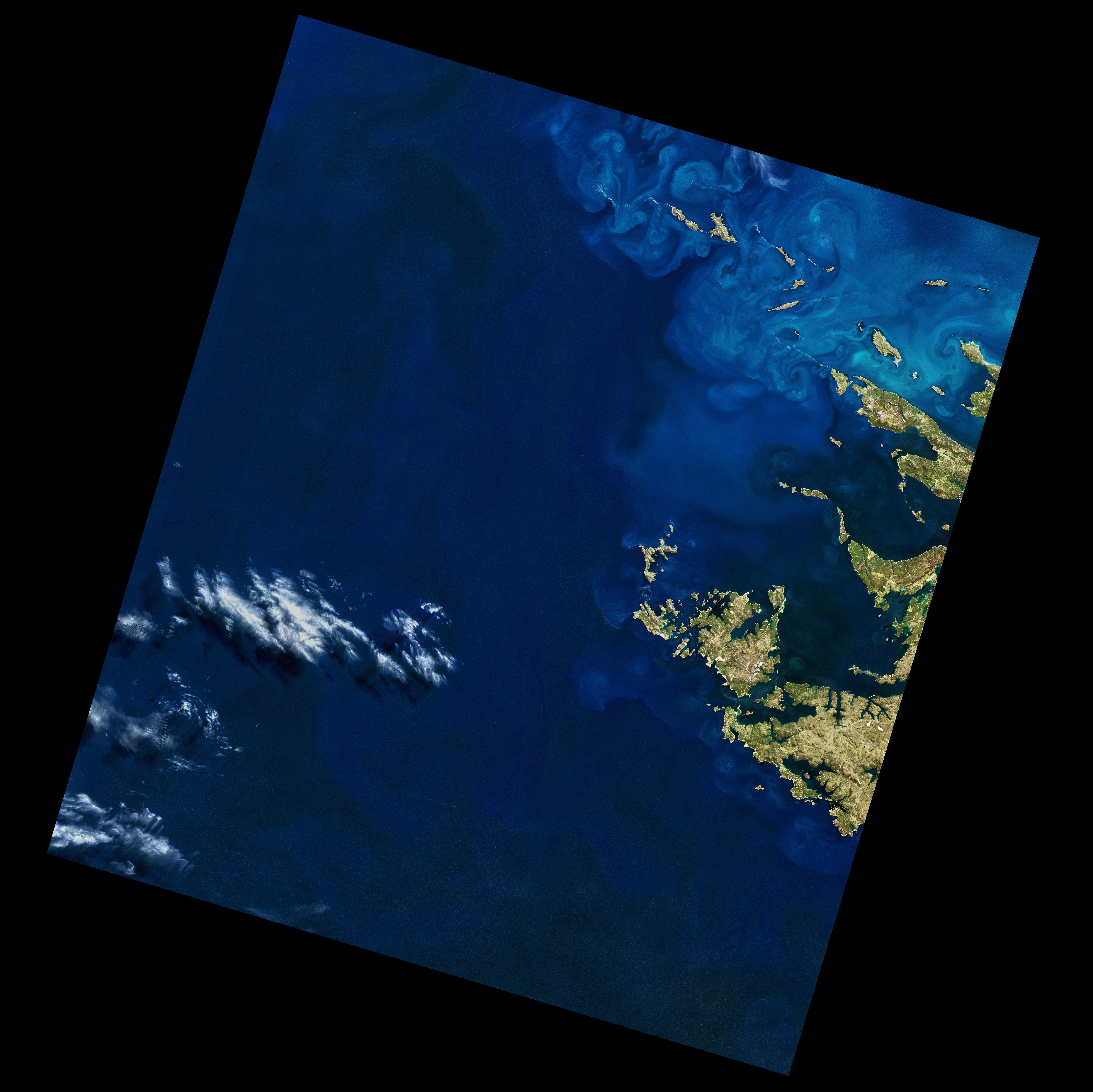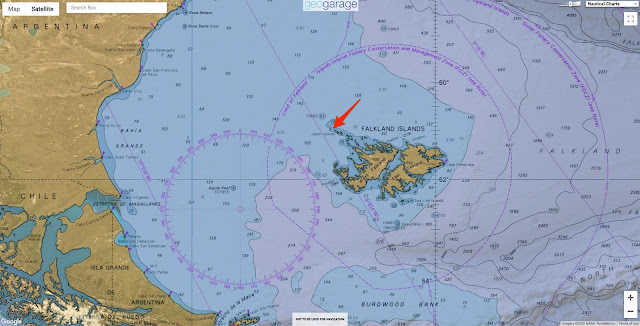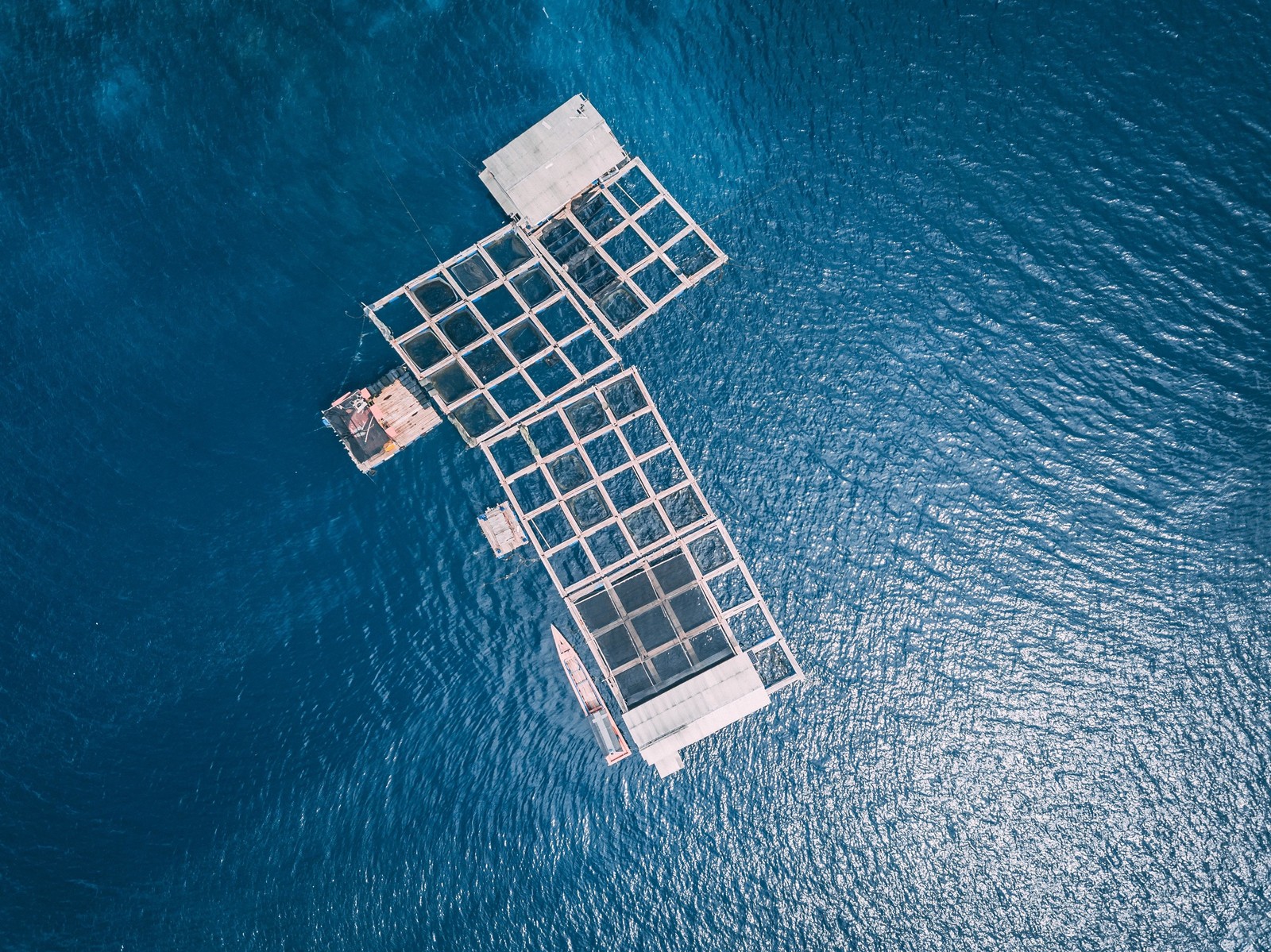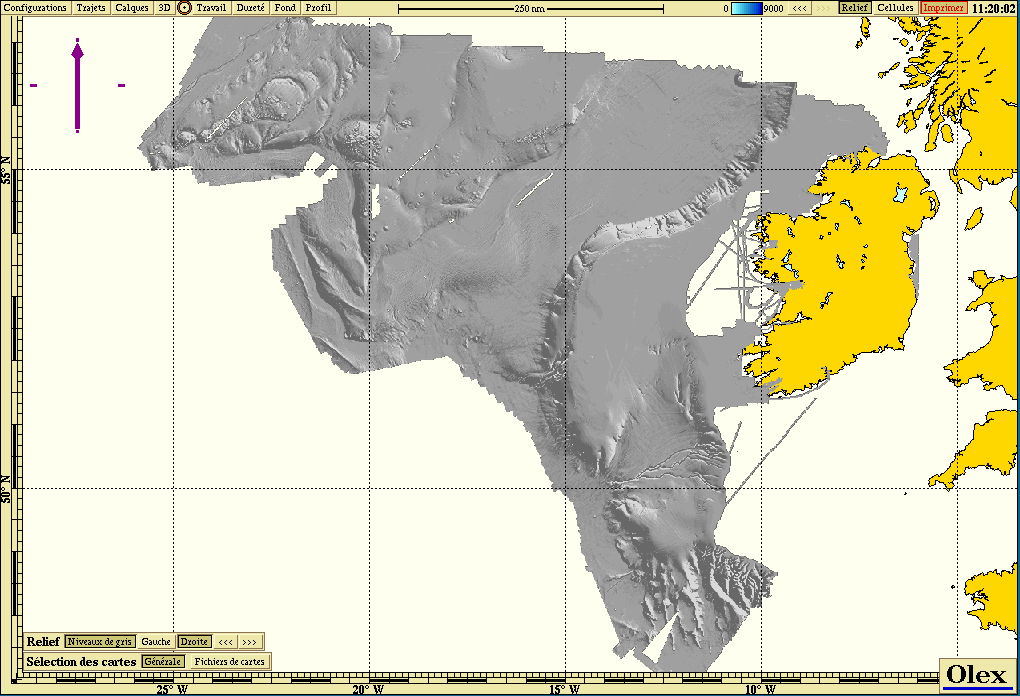Saturday, November 14, 2020
Copernicus Sentinel-6 measuring sea levels using radar altimetry
Friday, November 13, 2020
Detecting pollution from individual ships from space
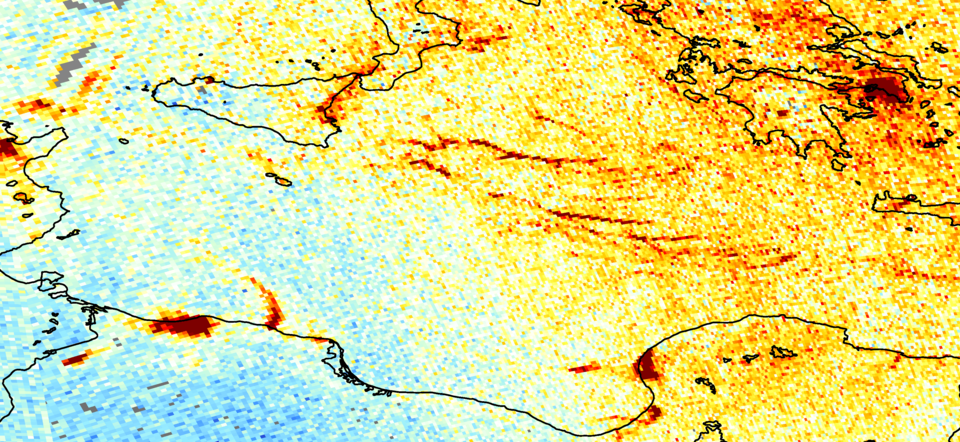 Nitrogen dioxide emissions over the Mediterranean
Nitrogen dioxide emissions over the Mediterranean
From ESA
For this reason, during the past decade, efforts to develop international shipping emission regulations have been underway.
Monitoring ships to comply with these regulations is still an unresolved issue.
Nitrogen dioxide concentration patterns under sun glint conditions
In a recent paper, an international team of scientists from the Royal Netherlands Meteorological Institute (KNMI), Wageningen University, the Human Environment and Transport Inspectorate of the Ministry of Infrastructure and Water Management, the University of Thessaloniki and the Nanjing University of Information Science & Technology, have now discovered patterns in previously unused ‘sun glint’ satellite data over the ocean that strongly resemble ship emission plumes.
Sun glint occurs when sunlight reflects off the surface of the ocean at the same angle that a satellite sensor views it.
Satellite algorithms tend to mistake such bright surfaces for cloudiness, which is why, for a long time, sun glint was considered a nuisance in satellite measurements.
When applying the same method for sun glint over oceans, the team were able to easily identify and attribute emissions from individual ships in daily Sentinel-5P measurements.
“For now, only the largest ships, or multiple ships travelling in convoy, are visible in the satellite measurements,” added Jos de Laat, from KNMI.
Claus Zehner, ESA’s Sentinel-5P Mission Manager, commented, “We think that these new results demonstrate exciting possibilities for the monitoring of ship emissions in support of environmental regulation from space. Future planned satellite missions with improved spatial resolution, for example the Copernicus Anthropogenic Carbon Dioxide Monitoring satellites, should allow for the better characterisation of nitrogen dioxide ship emission plumes and, possibly, detection of smaller ship plumes.”
Thursday, November 12, 2020
Could listening to the Deep Sea help save it ?
From NYTimes by Sabrina Imbler
You might know what a hydrothermal vent looks like: black plumes billowing from deep-sea pillars encrusted with hobnobbing tubeworms, hairy crabs, pouting fish.
But do you know what a hydrothermal vent sounds like?
To the untrained ear, a hydrothermal vent — or more precisely, one vent from the Suiyo Seamount southeast of Japan — generates a viscous, muffled burbling that recalls an ominous pool of magma or a simmering pot of soup.
To the trained ear, the Suiyo vent sounds like many things.
When asked during a Zoom call to describe the Suiyo recording more scientifically, Tzu-Hao Lin, a research fellow at the Biodiversity Research Center at Academia Sinica in Taipei, Taiwan, took a long pause, shrugged, and laughed.
People always ask him this, but he never has the answer they want to hear.
“I usually tell people to describe it with their own language,” Dr. Lin said.
“You don’t need to be an expert to say what it sounds like to you.”
Dr. Lin adores acoustics; in his official academic headshot, he wears a set of headphones.
He has listened to the sea since 2008, and to the deep sea since 2018.
He has deployed hydrophones, which are microphones designed for underwater use, in waters off Japan to eavesdrop on the noises that lurk thousands of feet below the surface.
He published these recordings in August at the a conference of the Deep-Sea Biology Society.
Dr. Lin is not interested in focusing on the song of a singular whale or the clatter of ship traffic, but rather on the habitat’s soundscape — the totality of all its sounds, human, animal and geological — to glean an area’s biodiversity.
Think of it as a hydrothermal vent’s acoustical calling card.
Dr. Lin joins a growing field of acousticians who believe that sound may be the quickest, cheapest way to monitor one of the most mysterious realms of the ocean.
A database of deep-sea soundscapes could provide researchers with baseline understanding of healthy remote ecosystems, and singling out the sounds of communities or even individual species can inform scientists when populations are booming.
“You need to know what the habitat sounds like when it’s healthy,” said Chong Chen, a deep-sea biologist at Japan Agency for Marine-Earth Science and Technology, or JAMSTEC.
“When the soundscape has changed, the habitat may have changed, too.”
The allure of deep-sea sound

Light holds little power in the ocean; it is so easily absorbed and scattered by seawater that anything deeper than 656 feet is essentially shrouded in darkness.
But sound reigns supreme underwater, where it travels five times faster than in air.
If this statistic seems abstract, several acousticians laid out a helpful scenario in a 2018 paper in Acoustics Today.
Imagine staring down at a city on a clear day from atop a mountain, the highest point within 60 miles.
You can see far into the horizon but only hear the sounds nearby, perhaps a chirping bird or a gust of wind.
In the deep sea, the rules are reversed.
Standing on a ridge several thousand feet underwater, peering out to the ocean’s abyssal plain, you would see almost nothing.
But if you listened through a hydrophone, you could detect sounds from hundreds of miles away: echolocating whales, chattering fish, even the occasional energy pulse from seismic surveys for oil and gas.
Scientists have long listened in on the sounds of the oceans, but only recently have they turned to the deepest, darkest parts of the sea, where sound holds promise as a portal into an unknown world.
Here, specialized creatures occupy habitats that would be fatal to surface-dwellers; when Dr. Lin’s colleagues retrieved the hydrophone from Suiyo, the vent’s heat had melted part of the cables.
“We got too close to the orifice,” Dr. Lin said with a sigh.
The deep sea is difficult to visit and expensive to observe; underwater robots do not come cheap.
But it’s fairly easy to drop a hydrophone overboard — along with a baited camera, to see if anything bites.
The hydrophone can pick up not just the noisy clicks of bickering dolphins but also the ambient hum of the deep-sea.
Snooping on soundscapes

Dr. Lin became interested in underwater acoustics around a decade ago as a graduate student at National Taiwan University, on a project observing Indo-Pacific humpback dolphins.
Although the project seemed exciting, he found the work anticlimactic, working long hours and seeing very few dolphins.
But as Dr. Lin listened to the recordings, he heard a chorus of other creatures — the sounds of snapping shrimp and choruses of fish — as well as noise pollution from industrial development.
“People are still really crazy about marine mammals,” he said.
“They do not really care about soniferous fish or invertebrates.”
When he joined JAMSTEC in the spring of 2019 for a yearlong stint as a postdoctoral research fellow, he was surprised by the remarkable diversity of deep-sea life, and even more surprised that few people had tried to capture the sounds of deeper-living creatures and their often volatile, volcanic habitats.
The work felt even more pressing as international interest in deep-sea mining continued to rise.
In 2019, he proposed the use of deep-sea soundscapes as a conservation tool in a paper in Trends in Ecology & Evolution.
Research cruises are expensive, and Dr. Lin did not have time to develop a dedicated cruise for deep-sea soundscapes.
So he and other researchers at JAMSTEC dropped hydrophones on already scheduled cruises, collecting daylong recordings from coastal areas near Japan and the Suiyo vent, and an even deeper recording from more than 18,000 feet below waters by the isosceles-shaped island of Minami-Tori.
He found that the shipping traffic drowned out the coastal soundscapes, but the Minami-Tori Shima recording picked up noise from dolphins, humans and the tectonic grumblings of the seafloor itself, as well as a potpourri of as-yet untraceable sounds.
Then the program will isolate individual sounds, such as dolphin whistles or chattering fish, and could even discover the sounds of new species.
Although the researchers are still poring through the data — recordings wrapped up in March — some soundscapes have already provided insight into life in the deep sea.
The Minami-Tori Shima recording revealed a chorus of fish that began right after sunset and ended after midnight at depths with no visible light.
“It’s really amazing,” Dr. Lin said.
Deep-sea detective work
 Benthocometes robustus, a type of cusk-eel.Credit...Paulo Oliveira/Alamy
Benthocometes robustus, a type of cusk-eel.Credit...Paulo Oliveira/AlamyWhereas the clicks and songs of marine mammals are well-documented, the identities of smaller deep-sea noisemakers are still shrouded in the dark.
At face value, deep-sea fish would not appear to be the most competent vocalists.
“Many fish sounds require hard parts like bone or dense muscles,” said Rodney Rountree, an adjunct professor at the University of Victoria who specializes in fish acoustics.
But some fish, such as the sailfin catfish, make sounds by rubbing their body parts together like crickets.
Then their air-filled swim bladders act like a drum to amplify the sound.
This movement can create sounds most often described as rasps, creaks or grunts — but these terms vary.
“It’s a big headache,” Dr. Rountree said.
“Even in the same study, I might call one thing a groan, and when I process it the next day I may call it a grunt.”
Other fish, such as cusk-eels, have dedicated sonic muscles that push on these bladders to bang like a drum or croak like a frog.
“It’s really loud, like a jackhammer,” he said, pausing and clearing his throat before demonstrating: “AH-AH-AH-AH-AH.” (If this reenactment is unclear, Dr. Rountree recorded this cusk-eel’s mating call.)
But many more gelatinous deep-sea species are bereft of such bladders, as well as the musculature needed to press against them.
A blobfish, after all, is more water than muscle.
Researchers have observed sonic muscles or have recorded sounds from five families of deep-sea fish, including grenadiers and sablefish, according to Marta Bolgan, a marine biologist at the University of Liege in Belgium.
“It is a very new field,” she said.
Dr. Bolgan recently published a paper in the journal Fish and Fisheries highlighting the importance of listening to deep-sea fish.

Some researchers are working to improve current listening technology.
At the Woods Hole Oceanographic Institution in Woods Hole, Mass., Ying-Tsong Lin is building a starfish-shaped contraption of hydrophones that can tune into certain sounds hundreds of miles away, like a telescope for sound.
Dr. Bolgan’s strategy involves attaching video cameras to recorders to capture fish vocalizing onscreen.
But even this is no sure thing.
A video that captures a fish and a fish-sound in the same frame still doesn’t prove that fish made that sound.
Researchers have to sleuth out whether that fish could physically make that sound, either by listening to existing recordings or speculating how the fish’s sonic muscles might produce noise.
“It is a combination of deduction and luck,” Dr. Bolgan said.
Even unidentified fish sounds can provide insight into biodiversity.
“If we cannot identify different types of signals, maybe we can estimate the abundance and distribution of animals on the deep-sea floor,” Dr. Lin of Academia Sinica said.
In an ideal world, researchers would be able to catch deep-sea fish and listen to them on land.
But benthic dwellers are difficult to haul up to the surface alive, let alone chipper.
“You have to keep them happy and healthy to make sounds,” Dr. Rountree said.
Fish often make sounds alongside particular behaviors, such as spawning, which can be difficult to replicate in a lab, although some researchers have succeeded.
In 2016, Eric Parmentier, Dr. Bolgan’s supervisor at the University of Liege, recorded cusk-eels growling in fiberglass tanks after sunset.
Floating egg masses the following morning indicated the fish had spawned.
Fishes may represent researchers’ best bet at parsing deep-sea biodiversity, as many key deep-sea animals are not known to make sound, according to Dr. Chen.
“Snails don’t vocalize,” he added as an example.
There are exceptions.
In 2019, researchers recorded remarkably loud snapping sounds from small, mouth-fighting marine worms that dwell in glass sponges.
And a 2017 study revealed that glass sponge reefs possess a distinct soundscape entirely their own.

Dr. Lin wants to make all his soundscapes available online for anyone to use.
This way, researchers such as Dr. Bolgan can sort through the recordings to single out a particular fish chorus, or any other particular sound.
“Once the data is digitized, it can be used over and over again,” Dr. Lin said, his voice catching with excitement.
“Future generations will be able to see what biodiversity was like decades ago.
” He uploaded all his recent recordings to SoundCloud, and invites any would-be acousticians to listen in.
Dr. Lin’s eventual goal, the Ocean Biodiversity Listening Project, is an international, open-access database of underwater recordings that can establish a baseline of healthy, deep-sea ecosystems.
He knows he’s working against the clock.
“Deep-sea mining is about to start anytime now,” Dr. Chen said.
In 2017, Japan successfully extracted zinc from the seabed off Okinawa.
“We need research cruises to incorporate soundscapes as part of their surveying,” Dr. Chen said, adding that the process should also be included in baseline environmental studies of potential mining sites.
Many deep-sea mining interests overlap with biodiversity hot spots, such as sulfide-rich hydrothermal vents.
Dr. Chen suspects that vent soundscapes may offer long-distance cues to deep-sea larvae looking to settle and start their lives on the seafloor.
“Chemical cues get diluted by seawater, but sound propagates very far, so it potentially has a very important role,” Dr.Chen said.
If deep-sea mining were to interrupt larval settlement, communities could take years to recover.
Dr. Lin continues to scan his soundscapes for any new patterns.
The recordings are still cryptic, a hazy bramble of ambience.
But at least for now, some reflect the racket of a deep sea that’s still noisy in the ways it’s supposed to be.
Links :
Wednesday, November 11, 2020
Image of the week : Jason and the Bloomonauts
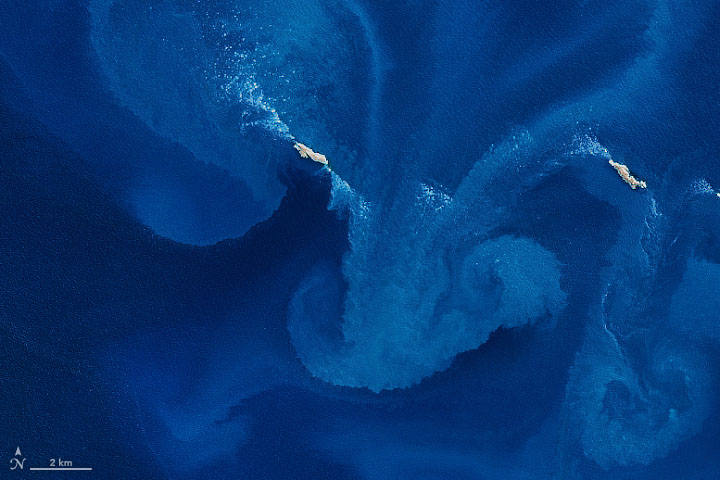
From NASA
The waters in this area are rich with nutrients carried on the Malvinas Current. Spun off of the Circumpolar Current of the Southern Ocean, the Malvinas flows north and east and is enriched by iron and other nutrients from Antarctica and Patagonia.
Jason Islands with the GeoGarage platform (UKHO nautical raster chart)
“The bright color suggests this might be coccolithophores, although its hard to say for sure,” said Marina Marrari, a biological oceanographer with the Costa Rica Fishing Federation.
“This is such a beautiful image. Although sediments can be suspended from the seafloor, the bright white really resembles a coccolithophorid bloom,” said Priscila Lange of the Blue Marble Space Institute of Science.
“These sub-mesoscale features are common in the shelfbreak region and north of Malvinas.
The area is also on the edge of what oceanographers call the “great calcite belt.”
The nearby Jason Islands were first noted on Spanish maps in the 16th century; evidence suggests they might have first been sighted by Ferdinand Magellan or Amerigo Vespucci.
In general, there are no permanent human inhabitants of the islands these days, other than occasional research teams and a few seasonal visitors.
Tuesday, November 10, 2020
What it takes to feed billions of farmed fish every day

From The Atlantic by Brian Payton and Hakai
This article appears courtesy of Hakai Magazine a s part of its special series Big Fish: The Aquacultural Revolution.
They’re usually just given ground-up fish.
One company is exploring a more sustainable alternative: maggots.
The air inside the greenhouse is abuzz with flying insects.
They rise and fall above endless trays teeming with their larvae.
Here at Enterra Feed Corporation’s research facility near Vancouver, British Columbia, the farmers don’t grow flowers or vegetables.
Instead, they farm soft-bodied, legless consumers of decomposing matter.
My guide, Andrew Vickerson, prefers that you not call them maggots.
Call them what you will; they appear to be little more than a mouth and trailing rolls of fat.
Once they’re past the larval (or grub) stage, during which they can grow as long as a paper clip, they metamorphose into winged adults.
With their bulbous eyes, wasplike antennae, and loud buzz, the adults seem intimidating—but, lacking mouths, they can’t bite or eat.
They live only to mate and lay eggs for the next generation.
Their entire life span is about 35 days.
They are best eaten while still young.
Vickerson waves the air in front of his face, chasing away escapees of the nearby breeding pens.
He was the first employee hired by Enterra back in 2009, when he was 25.
Environmentalist David Suzuki and Enterra CEO Brad Marchant (recently retired) had founded the company on a hunch.
Insects play an important role in the diet of fish in the wild, they reasoned.
Why not of farmed fish?
While Enterra considered using other insects early on, all the research kept pointing back to a single species:Hermetia illucens, the black soldier fly.
As Vickerson has learned, black soldier flies can be farmed extremely efficiently.
Enterra pioneered and patented some of these techniques.
But at the heart of their operation is a very low-maintenance livestock.
You don’t have to hunt, fish, or grow anything to feed black soldier flies.
They don’t require fresh water.
As larvae, they’re happy eating all manner of food waste that would have ordinarily gone to compost or the dump.
Black soldier fly grubs, Vickerson explains, can recycle those nutrients back into the food chain because, unlike many other insects, they can consume a wide variety of foods.
In the larval stage, they’re packed with protein and are high in fat, including the omega fatty acids highly prized by the aquaculture industry and consumers alike.
Native to the Americas, black soldier flies now range throughout the warmer parts of the world, although they don’t naturally occur in Canada.
In 2014, Enterra opened this football field–sized facility and began producing black soldier fly grubs (dried, whole), plus protein powder and omega-rich fatty oil made from ground-up grubs for aquaculture.
The protein powder and oil have caught the industry’s eye.
“We started the company to address two major global problems,” Vickerson explains.
“One is the need to feed a lot more people.
By 2050, we need to make 70 percent more food.
At the same time, we have limited resources—and 30 to 40 percent of the food we produce is wasted.” The bulk of this, explains Vickerson, is “pre-consumer” waste: food that either goes bad between the farm and the market or is a byproduct of food production.
Enterra turns that food waste into fat and protein that can be sold to fish-feed manufacturers.
It’s used in the aquaculture industry as a replacement for fish meal, which typically consists of ground-up fish and fish oil.
Aquaculture, the world’s fastest-growing food-production sector, is facing an existential crisis.
Our appetite for seafood continues to grow—but with nearly 90 percent of wild fish stocks already fully exploited, overexploited, or depleted as of 2018, feeding wildlife to livestock is an unsustainable business model.
Every day, the aquaculture industry has to feed billions of farmed fish.
Prevented from hunting or foraging for themselves, they’re left to watch for the hail of nutrients tossed from above.
One main source of those nutrients is wild “forage” fish stocks, which are made into fish meal.
A notable stock species is anchoveta, a small, oily fish that spawns off the coast of Chile and Peru twice a year.
The upwelling, nutrient-rich Humboldt Current can still result in schools so large they can be tracked by satellite.
Birds, marine mammals, and larger fish all compete for the bounty.
One of nature’s most spectacular events, it’s also the most heavily exploited fishery in the world.
Remarkably, only two percent of the total catch goes directly to feeding people; 98 percent is ground up into fish meal and fish oil and sold to the aquaculture industry in countries like China, Japan, and Norway.
Every year, 20 million tons of forage fish—anchoveta, but also herring, sardines, and mackerel—are removed from the world’s oceans.
Seventy percent goes to feeding farmed fish; most of the rest is fed to chickens and pigs.
The price of fish meal has risen as the industry grows and competition heats up for what remains.
Can alternative sources of nutrition for farmed fish be found that are both economically and environmentally sustainable? Scientists, corporations, and NGOs are scrambling to find the answer.
Some are looking further down the seafood chain at algae; some are looking beyond the sea to terrestrial crops.
Others, like Vickerson, are eyeing the endless supply of spoiled produce that never reaches market.
Whatever the solution, researchers say we need to find it fast.
Nothing less than the health of the world’s oceans—and our own food security—depends on it.
In the meantime, the aquaculture industry has gotten used to getting by with less.
In 1997, nearly three tons of forage fish went into producing one ton of salmon.
By 2017, forage fish made up only around 25 percent of a farmed salmon’s diet (down from 70 percent in the 1980s).
The United Nations’ Food and Agriculture Organization, or FAO, estimates that insects could replace anywhere from 25 to 100 percent of the remaining fish meal in the diets of farmed fish with no adverse effects.
That’s where the maggots come in.
The urgent beep, beep of backing trucks can be heard in the delivery bay as drivers tip their otherwise worthless cargo.
The seasonal menu includes a changing array of wilted lettuce, soft cucumbers, rotten tomatoes, stale bread, and moldy berries arriving from local greenhouses, farms, and bakeries.
We tour different sections of the facility, where countless trays and a waist-high conveyor crawls with wriggling grubs.
Millions of them fatten up by gobbling a smoothie-like slurry made from whatever comes off the trucks.
Only 1 percent will be allowed to live beyond the two-week larval stage.
Those lucky few are kept to mate and lay eggs for the next generation.
The remaining 99 percent gorge themselves and then ride the conveyor toward the light—in this case, a large dryer where they are roasted alive.
“We don’t have any arable land requirements,” Vickerson explains.
He also says this operation doesn’t create any methane.
“And we’re able to produce more nutrients per square foot than any other farming system, because it’s a vertically stacked system.”
Black soldier flies also offer an immunity boost.
Having evolved to grow in decomposing matter under crowded conditions, they can withstand some pretty nasty pathogens.
As a result, they’ve developed robust immune systems and don’t require penicillin or other pharmaceuticals like other livestock.
Researchers are studying whether they pass on some of that immunity as prebiotics when they themselves are consumed—an added benefit not found in fish meal.
Researchers at Fisheries and Oceans Canada conducted a study in which a captive group of Arctic char was fed a diet that included 20 percent black soldier fly grubs; a control group had none.
They measured growth rate, feed efficiency (weight gained divided by the amount of feed ingested), and survival rates for the first six months in the lives of the fish.
While there was no difference in growth rate or feed efficiency between the groups, the survival rate among those fed black soldier fly grubs was 28 percent higher.
“It’s significant,” Vickerson says.
“Something challenged the fish, and the insects they ate helped them overcome that challenge.
For fish farmers, it’s like a built-in insurance policy.”
He also points to the other benefits of feeding grubs instead of fish meal to farmed fish—like being able to tell end consumers that the fish they eat has a smaller environmental footprint, that it didn’t involve the consumption of wild fish stocks, and that its nutrients were upcycled from otherwise wasted food production.
All of which, he says, adds value.
Five years ago, regulatory approval for feeding Enterra’s insect products to food animals was the biggest obstacle between the company and the fish-feed market, but not anymore.
Enterra has made progress with US and Canadian regulators, Vickerson says, and has received approval to export to the European Union.
In the meantime, investors keep the conveyors rolling.
Along that lengthy regulatory path, Enterra discovered that its dried whole grubs are also well suited to the backyard poultry market.
And chickens aren’t the only birds that love grubs.
“Three to four billion dollars a year is spent on wild bird feed in the U.S.,” Vickerson explains.
“It’s a huge industry.” The global pet-food industry, worth more than $91 billion in 2018, is also taking note.
Vickerson says cats and dogs also like black soldier fly oil and protein.
In addition to pursuing these markets, Enterra collects the grubs’ dung—which falls like black dust below their trays—and sells it to local farmers as high-quality fertilizer.
The time has come to follow the conveyor to the end of the line.
Vickerson’s schedule is packed these days because he’s busy overseeing the opening of Enterra’s new production facility near Calgary, Alberta.
At nearly 17,000 square meters, that facility, which opened in February 2020, is bigger than three football fields and can house billions of grubs at any one time.
Beyond regulatory approval, what’s preventing aquaculture from the wholesale adoption of black soldier fly protein? It’s not price, Vickerson says; it’s volume.
Large, international fish-feed mills require a steady, reliable production of 3,000 to 4,000 tons of product per year.
The entire output of Enterra’s new, larger facility will barely meet the production needs of a single fish-feed mill.
To truly serve the global industry, Enterra will have to grow exponentially.
“We’re planning another five to 10 facilities over the next five years,” Vickerson says, “depending on market uptake.” Marion, Ohio, is next on the roster.
By 2030, roughly two-thirds of the fish we eat will likely come from aquaculture.
In the rush to meet the growing demand for fish feed, Enterra is not alone.
Other companies are working to bring black soldier fly grubs, other insect species, and various innovative sources of feed to market.
But for at least one group of concerned researchers and NGOs, the future can’t come fast enough.
They’re hoping to accelerate the process with a good old-fashioned contest.
Kevin Fitzsimmons is determined to disrupt the status quo.
You can hear it in his voice.
He’s in Myanmar, leading a three-year sustainable aquaculture program funded by the European Union.
In his life back home, he’s a professor in the department of environmental science at the University of Arizona and a research scientist.
He’s also a judge of the F3 (Fish-Free Feed) Challenge: a collaborative effort of NGOs, universities, researchers, and private partnerships.
He’s all too happy to get up early and talk fish feed across nine time zones.
“You know,” Fitzsimmons says, “I’m one of the people who got into aquaculture from the marine ecology, marine biology side of things.
I think probably the vast majority of old-timers like myself got into it saying, Jeez, we’ve got to stop raping and pillaging the ocean, and we can’t keep hunting and gathering wild seafood.
We’ve got to domesticate these things and do it more sustainably.”
Fitzsimmons, who’s also a former president of the World Aquaculture Society, has a unique global perspective on the industry.
He believes sustainability lies in replacing the wild fish in fish meal and fish oil, so forage fish can be left in the oceans for the seabirds, dolphins, and larger fish that depend on them.
One of the things that drives consumer interest in eating fish, particularly salmon, is omega-3 fatty acids.
But consumers are largely unaware that the amount of omega-3s in farmed salmon has declined significantly over the past 10 years.
This decline tracks with the decrease of fish meal in fish food and the remaining supply of fish meal being spread thinner as the industry grows.
Without alternative sources of fish-free omega-3s to feed the aquaculture industry, the world’s oceans won’t keep up with the demand for forage fish.
Fitzsimmons says this could result in major supply-chain disruptions—as well as ecological collapse.
Some fisheries have already collapsed.
Probably the most famous, he says, is the sardine industry in California, which collapsed back in the 1950s and 1960s due to overfishing.
“We are seeing the same phenomenon going on in many of these forage fisheries around the world.”
The anchoveta fishery off the coast of Chile and Peru is actually one of the few being managed in a more sustainable way, Fitzsimmons says.
Half of the world’s forage fisheries are desperately trying to establish catch limits, while the other half aren’t.
The ones without limits are being severely overfished—and the problem is getting worse.
For example, in Myanmar—which has more coastline than California, Oregon, and Washington state combined—fisheries (including forage fisheries) have collapsed by 70 to 90 percent.
That collapse is having ripple effects throughout the marine ecosystem.
And that’s just the environmental side.
Fitzsimmons also points to the labor abuses in forage fisheries throughout Southeast Asia.
Enter the F3 Challenge.
The first challenge, in 2015, asked contestants to create a fish-free fish feed for the aquaculture industry.
Guangdong Evergreen Feed Industry Company, a Chinese feed business, won more than $200,000 for its protein mix of soybean, rapeseed, and peanut meal.
In 2019, the second competition, which called for the creation of a fish-free fish oil substitute, saw four teams compete with various formulations for a $200,000 prize.
Veramaris, a joint venture between two Dutch companies, DSM and Evonik, won with its oil made from algae—which has twice the omega-3s of fish oil.
Combined, the four contestants sold approximately 850,000 kilograms of fish-free oil.
That saved the equivalent of more than two billion wild fish, the “largest amount of fish ever saved through a contest,” the organizers say.
For whatever reason, black soldier fly—which is further along in development—wasn’t among the formulations entered in the competition.
“Black soldier fly is one of these big targets,” Fitzsimmons explains.
“I mean, there must be 50 different companies around the world that are moving very, very rapidly into commercial production in scaling up black soldier fly.” Other companies are looking at different grubs (such as housefly, mealworm, and silkworm), beetles, crickets, and other insects.
“Ecologically, I think this is fantastic,” Fitzsimmons says.
He remains agnostic about what the best solutions might be, as long as they’re sustainable and become available quickly.
Fitzsimmons points to Norway, which has the world’s largest salmon-farming industry.
Over the last two or three years, roughly a quarter of Norwegian producers have switched from conventional fish oil to algae-based oils; forage fish get their omega-3s from algae in the first place.
Getting an industry that large to change that quickly is significant, Fitzsimmons says.
And he suspects it’s just the start: “We see a confluence of economics, environmental interest, sustainability, interest from consumers, and economies of scale as the companies rapidly increase their production.”
Algae oil, insect meal, soy, camelina (an oilseed crop), and hydrolyzed feather meal from the poultry industry will all be more sustainable than continuing to remove forage fish from the environment, Fitzsimmons explains, and they could all play a part in aquaculture’s future.
But there’s no silver bullet.
“There’s no one perfect algae oil that’s going to replace fish,” he says, “and there’s not any single protein source that’s going to replace fish meal.” He suspects solutions will come from multiple sources.
Consider the vegan diet, Fitzsimmons says.
If people are used to eating steak, they won’t find a single plant that will replace steak’s nutritional makeup.
In order to achieve the proper nutritional balance, they have to consume a variety of things.
Farmed fish don’t require fish meal or fish oil—they require the nutrients those ingredients happen to contain.
As long as they get—and can process—the proteins, amino acids, fats, vitamins, and minerals they need to thrive, it doesn’t really matter where they come from.
“We don’t have any vested interest in whether it’s insect protein or GMO soy or camelina—whether it’s a Cargill product or a little backyard startup,” Fitzsimmons says.
The F3 contests are about letting innovators compete in a free market and getting the word out to the general public.
He claims the contests have focused more media attention on the problem than “1,000 or even 10,000 scientific journal papers.”
Encouraged by the success of their first two competitions, the F3 Challenge team has cooked up a new contest.
The F3 Challenge–Carnivore Edition calls for participants to create a fish-free feed specifically for shrimp, salmon, or other carnivorous species.
That contest, with $210,000 in total prize money, was slated to run through September 2021, but deadlines are being extended because of the COVID-19 pandemic disruption.
Farmed carnivores have a larger environmental footprint than omnivorous species, such as tilapia, carp, and catfish—and much more so than bivalves like oysters, mussels, and clams.
Why focus on predator species when groups like the Monterey Bay Aquarium Seafood Watch program, the Aquaculture Stewardship Council, and the FAO all encourage consumers to eat further down the food chain? Because people want these species and are familiar with them, Fitzsimmons says—and because farmed carnivores are the industry’s biggest consumers of forage fish.
“If the market demand is there,” he says, “let’s feed it as sustainably as we possibly can.”
But the authors of at least one of those 10,000 overlooked scientific journal papers Fitzsimmons mentions call for a different approach.
They believe the answer lies not in serving market demand but shifting it.
And perhaps foregoing the need for fish feed altogether.
In 2017, Jennifer Jacquet, Jeff Sebo, and Max Elder published “Seafood in the Future: Bivalves Are Better” in the journal Solutions.
Lead author Jacquet is a Pew Marine Conservation Fellow and an assistant professor of environmental studies at New York University; she works on issues related to overfishing and aquaculture.
In their report, the authors found that the net contribution to the world’s food security through aquaculture—often used as justification for continued growth—seems to be “greatly exaggerated.” For example, farmed salmon is sold to food-secure markets, while the forage fish used to produce that salmon—like anchoveta—are removed from potential human consumption in markets that are less food secure.
“We are currently witnessing the fastest and most poorly thought out expansion of domesticated animals ever to occur—the expanding domestication of aquatic animals,” Jacquet and her fellow authors declare.
If done correctly, they say, aquaculture could provide sustenance for our growing population and reduce overfishing.
“But if we want to avoid repeating the same mistakes, we need to make changes now, including changing our diets generally to include more plants and fewer animals.”
Based on the criteria of environmental impacts, food security, and animal welfare, they conclude, the ideal species to farm through aquaculture would be species of aquatic plants (hello, seaweed and algae).
But if we insist on continuing to farm aquatic animals, “then the answer becomes species that are as plantlike as possible.”
Bivalves are nonmigratory invertebrates, not migratory vertebrates like salmon.
They’re highly nutritious, don’t require people to feed them, and (in some cases) even improve the environment around them.
Jacquet and her fellow authors argue that this makes them the most environmentally sound choice and the least worrying when it comes to animal welfare—an issue that’s mostly missing from the aquaculture discussion.
There’s an overwhelming public consensus, for example, that battery cages for chickens are unacceptable.
Why has the intensive farming of migratory salmon escaped this kind of scrutiny?
Jacquet and her co-authors agree with Fitzsimmons that forage fish should be left in the ocean for the marine life that depends on them, but they come to a different conclusion on how the aquaculture industry should proceed.
For more than 35 years, they claim, scientists have been calling on the industry to farm species lower on the food web, ones that require little to no feed.
“Bivalves accounted for almost half of global aquaculture in the 1980s, but due to the explosion in finfish farming now account for only around 30 percent,” they write.
“This is precisely the wrong trend if we want animal aquaculture to lead to a more food secure, sustainable, and humane future.”
The answer to aquaculture’s problems, they conclude, may lie in not simply replacing forage fish in fish meal and fish oil with novel ingredients like black soldier fly grubs, but in replacing farmed fish with farmed seaweed or farmed scallops, clams, and oysters.
Back at Enterra’s vertical farm, the aroma is rich and earthy.
Product is rolling off the conveyor in a steady stream.
Black soldier fly grubs pass through the dryer and then cascade into open bins.
The ones piling up below look much the same as they did before reaching the dryer, only now they no longer squirm.
The aquaculture industry is based on consumption and growth, not conservation.
The onus to choose ethically and sustainably produced food falls on consumers.
While Kevin Fitzsimmons believes we need to change what we feed farmed fish so we can continue to eat them, and Jennifer Jacquet and her co-authors suggest we grow and eat aquatic plants or bivalves, the FAO has been making the case for another food source altogether—one that does an end run around the entire seafood industry.
For reasons of health, sustainability, and conservation, it recommends we eat insects.
Insects have probably always been a part of the human diet.
Although eating them has fallen out of favor in the West—perhaps due in part to the fact that they’re seen as destroyers of crops—it wasn’t always this way.
The Greeks once relished their bugs.
Aristotle, the 4th-century Greek philosopher and scientist, loved cicada nymphs.
Roman scholar Pliny the Elder once wrote of the aristocracy’s taste for beetle larvae that had been raised on flour and wine.
The Old Testament endorses the consumption of locusts, beetles, and grasshoppers.
Around the world today, insects still regularly appear on the menu in Asia, Africa, and Latin America.
Insects provide high-quality protein and nutrients comparable to meat and fish, and in the case of black soldier fly grubs, omega fatty acids.
Although Andrew Vickerson says there’s growing interest in eating insects and notes that cricket flour can be purchased in many grocery stores today, he doesn’t predict a huge demand for black soldier fly grubs among North American consumers anytime soon.
For now, at least, he’s focused on helping feed the aquaculture industry.
I take up a handful of still-warm grubs, fresh from the dryer, and finger through identical options.
Vickerson joins me as I pop one into my mouth.
Not gelatinous or gooey, not too dry or crunchy.
Substantial.
Rich and oily.
Hints of roasted peanut with sunflower seed overtones.
Links :
- TheAtlantic : Wait, so how much of the ocean is actually fished? / Some fish are still full of mercury, for a worrying reason / The medieval practices that reshaped Europe’s fish
- CivilEats : The Continued Fight over Farming the Oceans / Can Aquaculture Survive Without Forage Fish?
- World Economic Forum : Sustainable fish farming? Prove it / Can the growth of aquaculture help restore the health of our ...
Monday, November 9, 2020
Ireland poised to be first in the world to map its entire seabed
From The Irish Times by Sylvia Thomson
Infomar project, to be completed by 2026, will help predict impact of storms and floods
“If we don’t have the data, we can’t make sustainable management decisions,” says Thomas Fury from the Marine Institute.
Fury is the joint manager – with Sean Cullen from the Geological Survey Ireland (GSI) – of the integrated mapping for the sustainable development of Ireland’s marine resources (Infomar), a project funded by the Department of Environment, Climate and Communications.
Its aim is to map Ireland’s entire seabed by 2026, becoming the first country in the world to have systematically mapped its marine territory.
This mammoth mapping task started with the Irish National Seabed Survey (1999-2005) which used remote sensing equipment, from multibeam to seismic, to survey vast stretches of offshore waters more than 200m deep beyond Ireland’s continental shelf.
Ireland’s continental shelf includes the land which extends under the sea to 200 nautical miles from the coastline, giving Ireland one of the largest seabed territories in Europe as shown on the so-called Real Map of Ireland.
The drive to have more data to better inform licensing decisions and promote sustainable development across shipping, port development, inshore fisheries, aquaculture, energy and tourism led to the continuation of this mapping exercise

Phase two, which will continue until 2026, aims to finish off the mapping of Ireland’s exclusive economic zone designated by the 1982 United Nations Convention on the Law of the Sea.
“We have mapped about 4,500sq km of inshore, coastal and shelf seabed each year since 2006 with 60,000sq km mapped to date. We have about 125,000sq km left to map in total,” Fury explains.
Surveying vessels
The Marine Institute co-ordinates the work of two large surveying vessels, including the Celtic Explorer, which bring three scientists out to survey waters beyond 30 nautical miles off the Irish coastline.
Understanding the topography (the surface structure and shape) and geology (the rock structure) of the seabed in Irish waters is crucial for any large offshore infrastructural projects, from wind farms to telecommunication cables and power cables.
“For example, we have discovered sand waves, which are mega dunes in the Irish Sea, which extend from the north to the south coast.
All of the Infomar findings are open-source data, available on global and European ocean datasets and portals to academic researchers and environmental consultants studying the viability of wave, wind and tide energy generation and oil and gas exploration and production.
Seabed mapping also provides key information about habitats that need to be protected and the conditions in which aquaculture projects will thrive or fail.
David O’Sullivan, chief scientist on the SeaRover (Sensitive Ecosystem Analysis and ROV Exploration of Reef Habitat) survey, says at the time the discovery – in an offshore special area of conservation in Irish waters – showed the significance of documenting sensitive marine habitats.
Coastal protection
Data from Infomar is also important for coastal protection and predicting the impacts of storm surges, floods and possible siltation, as well as protecting habitats from pollution.

“The oceanographic scientists were able to model the water flow, currents and nutrients in the semi-enclosed bay to assess the ecosystem tipping point from the commercial harvesting of shellfish,” Fury adds.
The maps and models provided “the catchment carrying capacity” based on the scientific knowledge and understanding of how much shellfish can be put in an enclosed area before it pollutes the water and reduces the growth rate of the shellfish.
Scientists at the Marine Institute collaborate with their counterparts around the world to advance understanding of the ecosystems in the ocean and how they will be impacted by climate change.
He sees huge potential for Ireland to use the seabed imaging to develop angling and diving tourism: “Ireland can show off its underwater like no other country can and once the imagery is linked to biology and topography, it’s a great resource.”
“Ireland’s offshore waters are steeped in maritime heritage and there are wrecks from historical European and transatlantic trading routes as well as Spanish Armada vessels from 1588 and modern-day fishing vessels which have sunk.”

Infomar programme
The Infomar programme became part of the Junior Certificate geography syllabus in 2018 (scoilnet.ie).
The mapping itself relies on multibeam echo sounder which spreads out like a fan on the seabed.
So-called sound velocity profilers measure the temperature, salinity and changes in the density of the water.
Remotely-operated high-definition cameras with robotic arms sit on the seabed gathering imagery which is combined with images from drones on the surface to accurately map habitats in specific areas.
Links :
- GeoGarage blog : Scientists reveal submarine canyon on edge ...
- Infomar : History of hydrographic mapping through the spyglass
